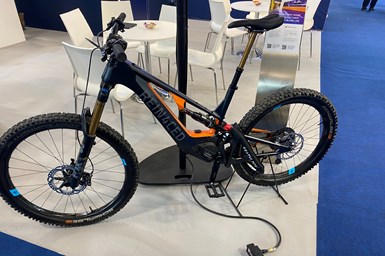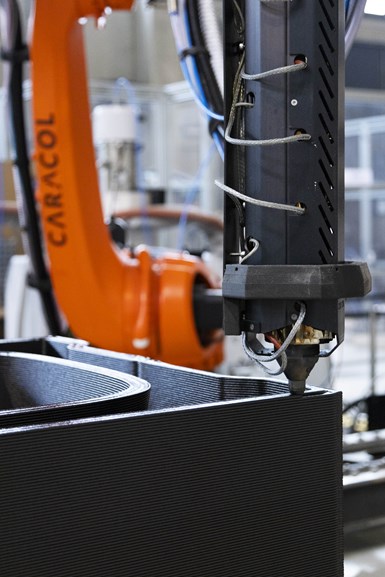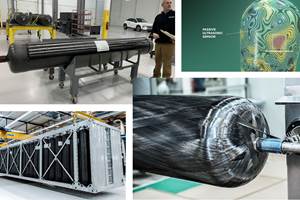JEC World 2024 highlights: Forwarding initiatives surrounding sustainability and mobility
Themes at the forefront of JEC World 2024 included solutions for mobility applications and sustainable materials, technologies and processes for composites manufacturing.
In early March, JEC World 2024 once again brought the composites community together in Paris, France. With the region in preparation for the 2024 Summer Olympic Games, numerous innovations were on display focused on the sports and recreation market. Additional themes that seemed at the forefront of the show included solutions for mobility applications and sustainable materials, technologies and processes for composites manufacturing.
Forwarding mobility and sustainability concerns
German machine and plant manufacturer Dieffenbacher (Eppingen, Germany) showcased technologies supporting the production of a variety of mobility solutions, ranging from automotive and transportation parts to sports and recreation. Examples of applications produced with Dieffenbacher equipment included battery housings, battery boxes and underbody covers for e-mobility applications, as well as bicycle components like frames and rims.
Composite technologies used for the parts on display included sheet molding compound (SMC), glass mat thermoplastics (GMT) and long fiber/ direct long fiber thermoplastic molding (LFT/D-LFT), as well as the company’s tailored blank line, including tape laying and consolidation technologies. Dieffenbacher’s core competence, the hydraulic press, plays a major role in all these processes.

Dieffenbacher and Rein4ced have collaborated on a fully automated bike frame production line, which will be expanded to other composite products. Source | CW
Recently, Dieffenbacher collaborated with bicycle manufacturer Rein4rced (Leuven, Belgium) to advance the production of carbon fiber-reinforced thermoplastic (CFRTP) bicycle frames, one of which was on display. Rein4ced’s hybrid material, “Feather,” combines carbon fiber with steel fibers for enhanced impact resistance.
The partnership has resulted in the design and construction of a thermoplastic production line in Leuven, Belgium, leveraging Dieffenbacher’s expertise in automated production. Based on its tailored blank line, the new line automates the laying and consolidation of unidirectional (UD) tapes, ensuring proper fiber orientation and reducing material porosities. The factory also serves as a pilot facility for mass-producing composite products.
Dieffenbacher also showcased its digitalization platform Evoris, which employs artificial intelligence to enhance plant efficiency. The technology is being integrated into variable-speed pump drives in the Fiberpress hydraulic press and for adaptive accumulator management in hydraulic drive systems. These technologies aim to minimize energy consumption and optimize raw material use.

The Syensqo booth at JEC World 2024. Source | CW
Syensqo (Brussels, Belgium), formerly part of the Solvay Group, has long been a key player in the aerospace and automotive industries, focusing on lightweight, high-performance composite materials and efficient processing technologies. The company used JEC as a platform to highlight new advancements and partnerships.
The company is working with numerous electronics companies on further integration of composite materials in smart devices and electronics, addressing needs for thinner, lighter and more rigid components. One example is the use of ceramic fiber composites in a foldable phone, improving thermal management and durability.
Syensqo is also focused on electrification, hydrogen propulsion and bio-sourcing, reflecting its commitment to advancing human progress. Notable collaborations include partnering with Climate Impulse for a green hydrogen-powered flight project and supplying advanced materials to unmanned air systems (UAS) manufacturer Schiebel (Vienna, Austria) and drone delivery company Manna Drone Delivery (Dublin, Ireland). Syensqo is committed to providing sustainable solutions, including work with Trillium Renewable Chemicals (Knoxville, Tenn., U.S.) to create bio-based carbon fiber composites, demonstratingits dedication to reducing emissions and supporting environmental goals.

COAST is capable of precise measurement and defect detection on contoured composite surfaces during the AFP process, reducing costs and increasing AFP accessibility. Source | Fives
Process innovation
Fives (Hebron, Kentucky, U.S. and Paris, France) used JEC World as an opportunity to promote its composite optical automated surface tracking (COAST) in-process composite inspection technology. COAST uses optical coherence tomography (OCT) technology, originally from the medical industry, to accurately measure material defects during the automated fiber placement (AFP) process. It seamlessly integrates surface measurements with machine position data and computer-aided manufacturing (CAM) data, enabling real-time defect detection. COAST’s advantages include optimized signal quality during machine head rotation and precise 3D point cloud generation for defect detection algorithms. This technology automates data collection and quality analysis, providing rapid feedback to designers and manufacturing engineers, thereby improving process efficiency.
Successful deployment in a customer facility demonstrated quicker defect assessment compared to manual inspection techniques. Fives anticipates a 90% reduction in inspection and rework time by 2024, with COAST poised to revolutionize AFP quality specifications and drive increased equipment effectiveness and cost reduction for end users. COAST “1.0” is available for integration into Fives AFP machines, with plans for integration into third-party machines and ongoing R&D to enhance data collection capabilities. This innovation is the result of collaborations with the Canadian National Research Council (CNRC) and a current customer experienced in in-process inspection (IPI), leading to tangible efficiency improvements.

Hexcel HexTow IM9 24K. Source | CW
Material innovation
Hexcel Corp. (Stamford, Conn., U.S.) introduced a new continuous carbon fiber called HexTow IM9 24K, offering a lightweight, robust and long-lasting composite material option for various applications. The carbon fiber comprises 24,000-filament intermediate modulus (IM) fibers, boasting tensile strength exceeding 6,300 megapascals (MPa), a modulus of 298 gigapascals (GPa) and a strain capacity of 1.9%. Compared to Hexcel’s baseline IM7 fiber, HexTow IM9 24K demonstrates a 12% enhancement in tensile strength, making it particularly suitable for aerospace applications such as manufacturing primary and secondary aerospace vehicle structures.
Hexcel expects to qualify the product with a range of high-performance resin systems, including toughened epoxies, thermosetting bismaleimide (BMI), and out-of-autoclave (OOA) options. Composites data is being generated across various resin systems to provide customers with comprehensive information about this new product. HexTow IM9 24K is positioned to offer significant value due to its high performance, tensile strength and increased productivity, all resulting from its 24K tow size.

CMS SpA and Caracol announced a collaboration to advance the global large-format 3D printing market Source | Caracol
3D printing in composites
CMS SpA (Zogno, Italy) and Caracol (Milan, Italy) announced a collaboration to advance the global large-format 3D printing market. CMS SpA, a division of Scm Group, is known for its expertise in composite material processing technologies, serving such sectors as aerospace, automotive and marine. The company’s additive manufacturing (AM) journey began in 2018 with CMS Kreator, offering both hybrid machines merging additive and milling technologies and standalone printing machines. Caracol, established as a startup in 2017 and now a global scaleup, specializes in robotic large-format 3D printing with the Heron AM platform, serving various sectors including aerospace, marine, automotive, design and architecture. Through collaboration, the companies seek to leverage their respective strengths in robotics and machining to provide clients with the advantages of AM for large-scale components.

This carbon fiber duct was created using a wash-away mold printed using Massivit’s printing technology and water-breakable material by Sika. Source | CW
Massivit (Lod, Israel) showcased its 10000-G 3D printing technology designed for making composite tooling. The machine is capable of printing a shell from a water-breakable material co-developed with Sika (Bad Urach, Germany). Epoxy-based resin can then be added inside to create a high-end mold, jig or fixture. “You can print with water breakable material, lay up the fiber on it and then put it in water after the layup. The mold material then falls apart and you are left with a geometry that cannot be created using any other molding technique,” says CEO Erez Zimerman.

Pictured clockwise: Thermoplastic panel (Composite Technology Center); 3D woven Airbus Wing of Tomorrow rib (Albany Engineered Composites); ASPERA-welded thermoplastic composite demonstrator (Spirit Aerosystems); thermoplastic fuselage panel (Korea Aerospace Industries); torsion box demonstrator (Daher)
Source | CW
Thermoplastics in aerospace
The exploration of thermoplastics in aircraft manufacturing remains a prominent subject of discussion as the industry waits in anticipation for the announcement of a new commercial aircraft program. At this year’s JEC World, several demonstrators showcasing the application of thermoplastic composites in aerospace structures were featured, including the following JEC World Innovation Award Finalists:
- A curved thermoplastic panel manufactured by Composite Technology Center (CTC GmbH, Stade, Germany) using hydrostatic membrane press technology, which enables production of high-temperature thermoplastic composites with a high laminate quality. The technology is suitable for one-shot consolidation of parts while integrating stiffeners in the process. The longitudinal joint was created using conduction welding.
- A 3D woven rib for the Airbus Wing of Tomorrow (WOT) program fabricated by Albany Engineered Composites (AEC, Rochester, New Hampshire, U.S.) using carbon fiber 3D woven preforms and epoxy resin in a resin transfer molding process. AEC’s preforms were designed using its #DCS design suite and weaving systems to produce a complex integrated structure.
- The ASPERA-welded thermoplastic composite demonstrator from Spirit Aerosystems (Wichita, Kan., U.S.) fabricated using AFP, stamp forming and novel pressure intensification process that were welded together using co-fusion and induction welding methods.
Additional demonstrators at the show included a torsion box demonstrator from Daher (Nantes, France) representing a rivetless horizontal stabilizer for aircraft applications using thermoplastic composites, induction welding, direct stamping and co-consolidation, as well as a thermoplastic fuselage panel by Korea Aerospace Industries (KAI, Sacheon-si, South Korea).
Related Content
Bio-based acrylonitrile for carbon fiber manufacture
The quest for a sustainable source of acrylonitrile for carbon fiber manufacture has made the leap from the lab to the market.
Read MoreHexagon Purus Westminster: Experience, growth, new developments in hydrogen storage
Hexagon Purus scales production of Type 4 composite tanks, discusses growth, recyclability, sensors and carbon fiber supply and sustainability.
Read MorePlant tour: Middle River Aerostructure Systems, Baltimore, Md., U.S.
The historic Martin Aircraft factory is advancing digitized automation for more sustainable production of composite aerostructures.
Read MoreNovel composite technology replaces welded joints in tubular structures
The Tree Composites TC-joint replaces traditional welding in jacket foundations for offshore wind turbine generator applications, advancing the world’s quest for fast, sustainable energy deployment.
Read MoreRead Next
JEC World 2024 highlights: Thermoplastic composites, CMC and novel processes
CW senior technical editor Ginger Gardiner discusses some of the developments and demonstrators shown at the industry’s largest composites exhibition and conference.
Read MoreJEC World 2024 highlights: Glass fiber recycling, biocomposites and more
CW technical editor Hannah Mason discusses trends seen at this year’s JEC World trade show, including sustainability-focused technologies and commitments, the Paris Olympics amongst other topics.
Read MoreAll-recycled, needle-punched nonwoven CFRP slashes carbon footprint of Formula 2 seat
Dallara and Tenowo collaborate to produce a race-ready Formula 2 seat using recycled carbon fiber, reducing CO2 emissions by 97.5% compared to virgin materials.
Read More






















